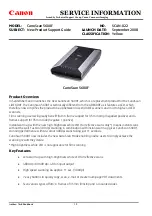
DT-01715C
Travel Document Reader User Guide
© 3M 2006 All rights reserved.
15
•
The READY LED turns on, indicating that the reader is ready to scan another
document.
The data from the test card is sent to the host computer and the results displayed on the PC
screen.
Reading Documents
The readers read the barcode and machine-readable zone (MRZ) text on both identification cards
and passports. When the document is properly aligned on the document window, the image is
taken and optical character recognition is performed (when there is OCR data) followed by the
barcode recognition.
Barcodes uniquely identify each passport with specially encoded information about the
document holder. Single or two dimensional barcodes may be used.
Single dimensional (1D) barcodes encode information along their width. Each character of the
alphabet is represented by a specific combination of thick and thin bars and spaces. To add more
information, the width must be increased. This eventually poses problems for secure document
issuers due to the lack of free space available for the barcode.
Two dimensional (2D) barcodes encode information vertically as well as horizontally. This
allows 2D barcodes to contain more information than 1D barcodes with more information
packed into a smaller space.
Reading ID Barcodes
1D barcodes are usually printed at a resolution level that allows them to be accurately captured
by most optical scanners such as the 3M™ Full Page Reader. Their images are usually easily
decoded by a PC-based application.
The readers read three kinds of 1D barcodes:
•
2 of 5 interleaved
•
Code 39 (Code 3 of 9)
•
Code 128
Reading 2D Barcodes
Because of their detail, 2D barcodes are most often printed at a high resolution. Many factors
may affect the ability of a software application to accurately decode the barcode’s information
from a scanned image. These include:
•
low resolution, poor, faded or fuzzy printing is potentially problematic
•
undersized or skewed bar codes cannot be reliably read
•
large feature size (bar density) may reduce legibility
•
insufficient contrast between print and paper may cause inaccurate reads
•
interaction of the ink and paper may result in image bleeding or blurring over time
•
laminates that affect image clarity reduce readability
Summary of Contents for Full Page Reader
Page 8: ......
















































